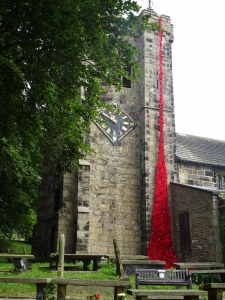On Friday 13th April 2018 a group of people from the project visited the Bankfield Museum, Halifax, the home of the Duke of Wellington’s Regimental Museum.
Many of the Farnhill WW1 Volunteers served in the Duke of Wellington’s (West Riding) Regiment and we spent about two hours looking at the displays dedicated to the regiment’s history and a special exhibition entitled “For King and Country”, about the First World War, which runs until 22 December 2018. We were shown round by John Spencer, Curator of Military History, who was kind enough to spend all morning with us.
There was also time afterwards to see other parts of the museum including textile displays and the library, and to take in the historic surroundings of the former Victorian mansion in which it is housed.
A visit, not just for the regimental display but to see the museum as a whole, is highly recommended.
Going by the feedback received afterwards it was a very enjoyable and informative experience.
Feedback & Photographs
Below are some photographs taken during our visit and people’s opinions on the museum and the WW1 displays. (Note that the views expressed are not necessarily those of the people shown in the photograph next to them.)

One of the many interesting exhibition display boards
The displays were interesting
“The special WW1 display was exceptional.”
“Items were well laid out in easily viewed cases, items hung on walls were at a good height and signage was well written and informative. It provided a very good overview of the war.”
“Displays were interesting and informative being well laid out and well-lit so easy to see.”

John Spencer, curator, (right) guided us round the exhibition
We were shown round by John Spencer, Curator of Military History (on the right)
“John added tremendous value to the visit.”
“He was knowledgeable, open to questions, acknowledged those areas where his knowledge was imperfect or where our knowledge of a topic might exceed his.”
“What a great curator. So knowledgeable and obviously passionate about history.”


The exhibits promoted discussion and quiet contemplation
The visit was interesting and informative
“It was interesting to discover more about the history of the Regiment from how it got its name to the conflicts it was involved in.”
“I have visited this museum several times in the past. The Duke of Wellington’s display area is of particular interest although, until my involvement with our project, I didn’t really appreciate the local connection.”
“Seeing the collections of personal artefacts and uniforms made everything more real, more personal.”
There was time for reflection …
“…the tragedy of so many young men losing their lives, often in the most horrendous circumstances…”
“It makes me thankful that most men from our village survived active service but no wonder many chose not to talk about it.”
… and for recommendation
“I would certainly recommend anyone interested in Military history and the Duke of Wellington’s Regiment to visit Bankfield”
“I think it is very likely that I will visit Bankfield museum again.”
“Besides the military history there are other exhibits and the building itself is impressive.”
Bankfield Museum is open Tuesday to Saturday, 10am to 4pm. Admission is free
The WW1 exhibition, “For King and Country”, runs until 22 December 2018.





 Work started this week on restoration of the Farnhill Methodist WW1 Roll of Honour.
Work started this week on restoration of the Farnhill Methodist WW1 Roll of Honour.








